
NEW YORK (AP) – If you’re spending a lot on convenience — whether in the form of grocery delivery, ride-hailing or meal delivery — your credit card wants to reward you for it, while encouraging you to spend more.
Join our WhatsApp groupSubscribe to our Daily Roundup Email
Consider these recent offerings:
— Chase announced in January that for a limited time, eligible cardmembers can get free memberships to DoorDash’s subscription food delivery service, DashPass, valued at $9.99 a month. The Chase Sapphire Reserve also now offers a complimentary one-year Lyft Pink subscription, which comes with several perks.
— The Capital One Walmart Rewards Mastercard, launched in October, offers its highest rewards, 5% back, on purchases made online and through the Walmart app, which includes Walmart Grocery Pickup and Delivery.
— The recently revamped Uber Credit Card now offers 5% back on Uber and Uber Eats.
— The new Apple Card offers 3% back on Uber and Uber Eats when you use the card through Apple Pay.
While it might seem like credit cards are acting like your new best friend, ready to help you pick up groceries or bring you lunch, experts say their rewards structures are designed to get you to use the cards more freely. Convenience, in other words, can come at a cost.
‘AN ANTIDOTE TO ANXIETY’
Credit card issuers are tapping into a popular spending category. A June 2019 survey commissioned by Finder.com, a data comparison website, found that 74% of Americans spend just over $4,000 a year on conveniences, including food deliveries and ride-hailing.
“Consumers are spending more money on services that provide more convenience, and card issuers are recognizing this is a growing category of spending, so they offer consumers higher rewards levels in an attempt to make the card more frequently used,” says Ron Shevlin, director of research at Cornerstone Advisors, a banking consultancy.
Convenience is an attractive feature for all consumer groups, says Kit Yarrow, consumer psychologist and professor emerita at Golden Gate University. The reason?
“Convenience is an antidote to anxiety,” Yarrow adds. People reduce their overall stress — and make themselves feel better — by ordering groceries to be delivered, getting takeout or having someone else do the driving, she says.
Credit card issuers want to benefit by being the method consumers use to pay for that peace of mind.
THE COST OF CONVENIENCE
Many of these perks, though, aren’t automatic for the cardholder, which is a bit ironic.
“While convenience is growing as a reward category, credit card management is actually becoming less convenient,” Shevlin says.
With Chase’s DashPass benefit, for example, cardholders need to opt in to the offer to receive it, which takes effort.
“It requires more proactivity on the part of the consumer,” says David Morris, a senior consultant for Packaged Facts, a market research publisher. “If you don’t opt in, you don’t get the reward, which is also a way to help (the issuer) control rewards costs.”
Shevlin notes that to fully optimize some of these deals, consumers may need to also update the card they have connected to the apps so that it’s the one that offers the highest rewards rate on that service.
“Now you have to actively manage which card you use for each transaction,” Shevlin adds.
‘THE EASIER IT IS TO PAY, THE EASIER IT IS TO SPEND’
Morris says it’s also important to pay your bills in full each month to avoid accumulating debt and paying interest, which would cancel out the benefit of any rewards earned.
“These rewards are all meant to promulgate a purchase, so the consumer needs to be aware of what they should and shouldn’t spend,” he says.
To avoid overspending, Yarrow says consumers should track their spending carefully. “The easier it is to pay, the easier it is to spend,” she says, which means if you use a ride-hailing service and pay for it on your phone without pulling out your wallet, it can feel like you haven’t even spent anything, when, of course, you have.
With many of these convenience-oriented apps and services, “it’s just so easy to buy,” Yarrow says. “People need to implement other methods to understand the costs,” she says, such as reviewing your credit card statement each month.
Other cost-cutting strategies include setting a budget and reviewing it regularly, limiting the apps linked to your credit card, and eliminating subscription services that you don’t use regularly.

This is all about getting us to spend more
And get deeper in debt
You can beat the credit card companies by using cards that offer 2% or 3% back on all purchases and pay off the balances each month. There are frequent offers of cards with bonus rewards or miles for spending as little as $3000 in 3 months. Chase and Discover and possibly other cards have categories of purchases every quarter that give as much as 5x bonus rewards. Always pay off the balances unless you have a 0% card.